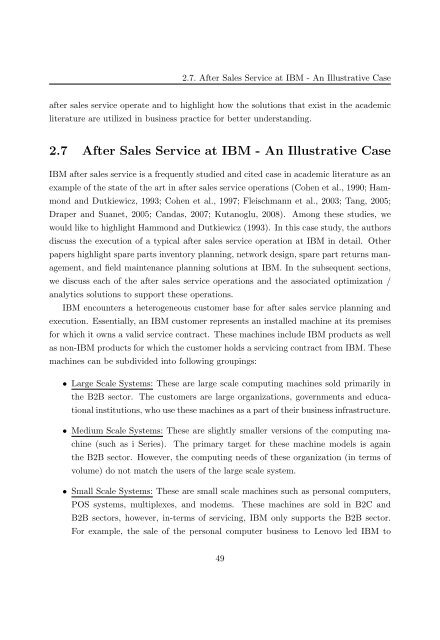Customer Information Driven After Sales Service ... - RePub
Customer Information Driven After Sales Service ... - RePub
Customer Information Driven After Sales Service ... - RePub
You also want an ePaper? Increase the reach of your titles
YUMPU automatically turns print PDFs into web optimized ePapers that Google loves.
2.7. <strong>After</strong> <strong>Sales</strong> <strong>Service</strong> at IBM - An Illustrative Case<br />
after sales service operate and to highlight how the solutions that exist in the academic<br />
literature are utilized in business practice for better understanding.<br />
2.7 <strong>After</strong> <strong>Sales</strong> <strong>Service</strong> at IBM - An Illustrative Case<br />
IBM after sales service is a frequently studied and cited case in academic literature as an<br />
example of the state of the art in after sales service operations (Cohen et al., 1990; Hammond<br />
and Dutkiewicz, 1993; Cohen et al., 1997; Fleischmann et al., 2003; Tang, 2005;<br />
Draper and Suanet, 2005; Candas, 2007; Kutanoglu, 2008). Among these studies, we<br />
would like to highlight Hammond and Dutkiewicz (1993). In this case study, the authors<br />
discuss the execution of a typical after sales service operation at IBM in detail. Other<br />
papers highlight spare parts inventory planning, network design, spare part returns management,<br />
and field maintenance planning solutions at IBM. In the subsequent sections,<br />
we discuss each of the after sales service operations and the associated optimization /<br />
analytics solutions to support these operations.<br />
IBM encounters a heterogeneous customer base for after sales service planning and<br />
execution. Essentially, an IBM customer represents an installed machine at its premises<br />
for which it owns a valid service contract. These machines include IBM products as well<br />
as non-IBM products for which the customer holds a servicing contract from IBM. These<br />
machines can be subdivided into following groupings:<br />
• Large Scale Systems: These are large scale computing machines sold primarily in<br />
the B2B sector. The customers are large organizations, governments and educational<br />
institutions, who use these machines as a part of their business infrastructure.<br />
• Medium Scale Systems: These are slightly smaller versions of the computing machine<br />
(such as i Series). The primary target for these machine models is again<br />
the B2B sector. However, the computing needs of these organization (in terms of<br />
volume) do not match the users of the large scale system.<br />
• Small Scale Systems: These are small scale machines such as personal computers,<br />
POS systems, multiplexes, and modems. These machines are sold in B2C and<br />
B2B sectors, however, in-terms of servicing, IBM only supports the B2B sector.<br />
For example, the sale of the personal computer business to Lenovo led IBM to<br />
49

















